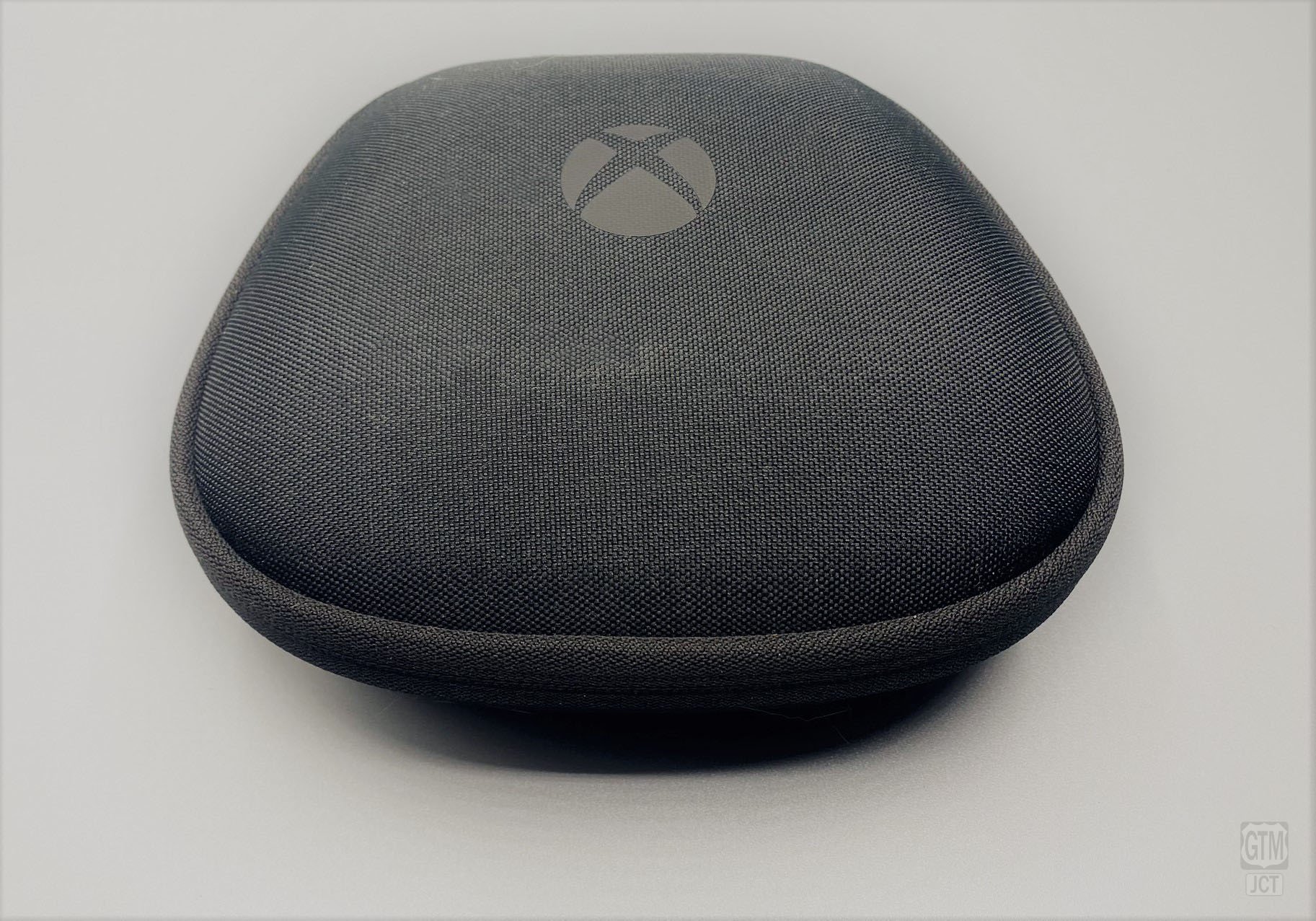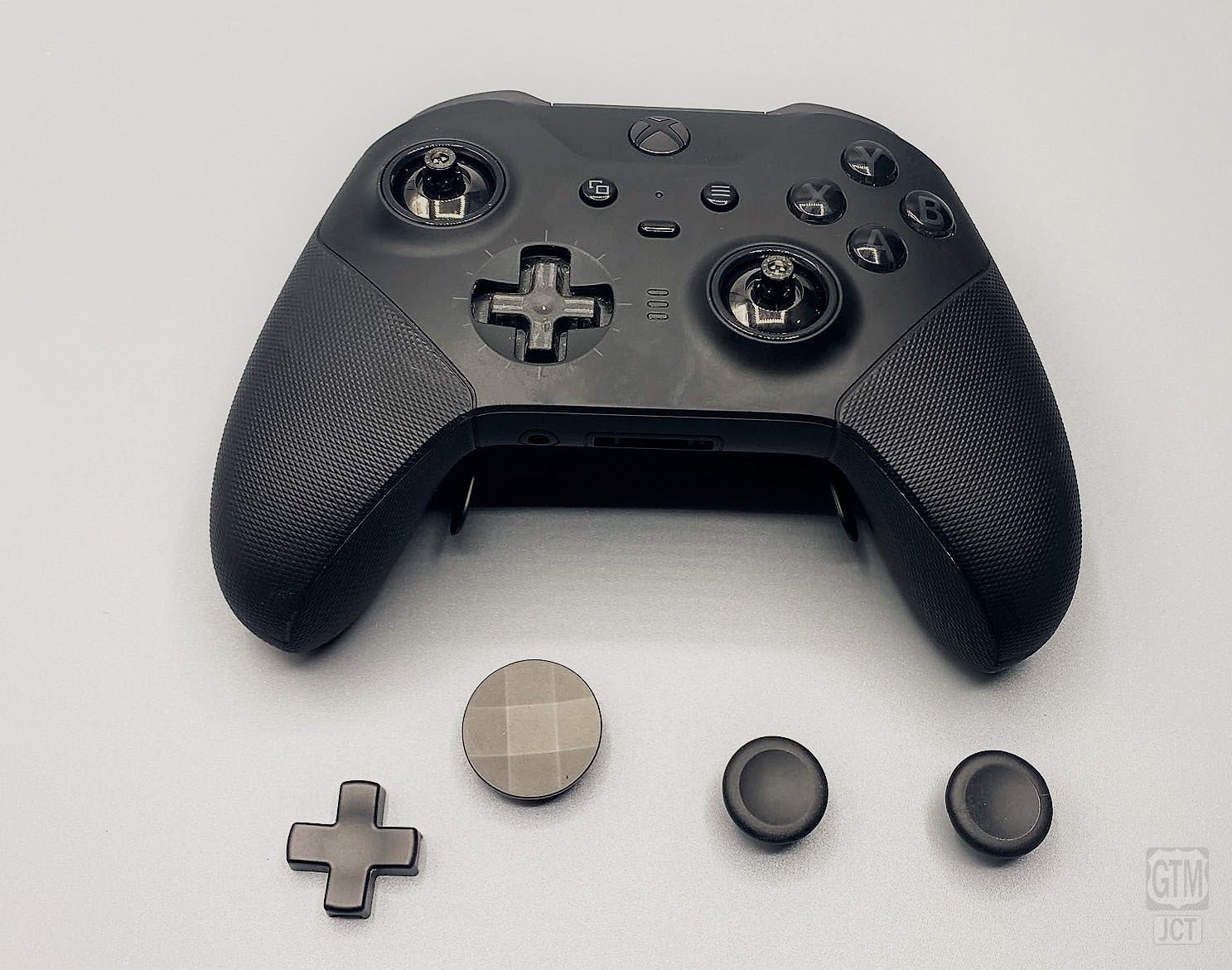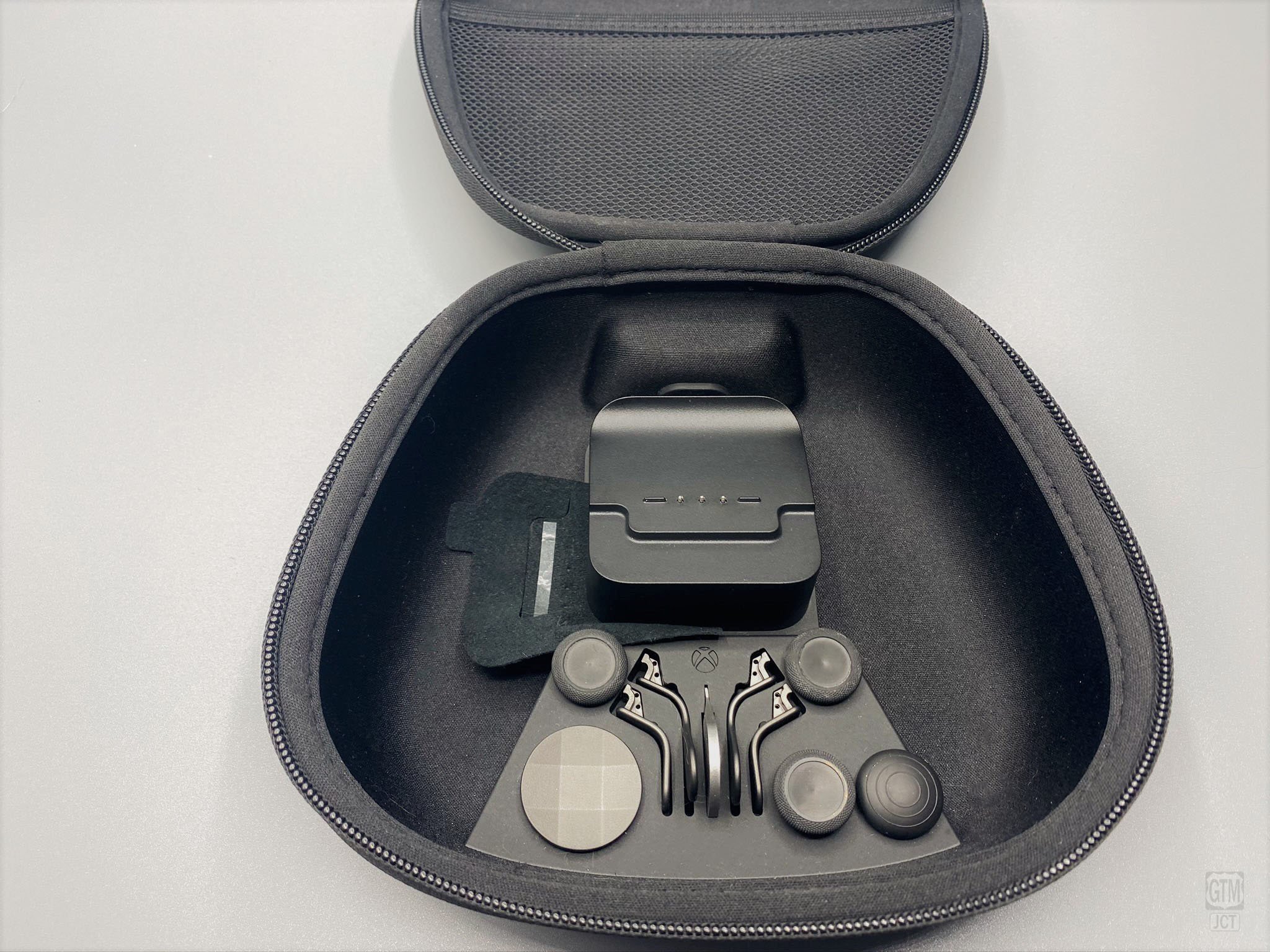The Xbox Elite Series 2 Review
by UnkemptStatue
08/01/20
Looks: ★ ★ ★ ★ ★ ★ ★ ★ ★ ★ (10/10)
Comfort: ★ ★ ★ ★ ★ ★ ★ ★ ★ ☆ (9/10)
Build Quality: ★ ★ ★ ★ ★ ★ ★ ★ ★ ☆ (9/10)
Features: ★ ★ ★ ★ ★ ★ ★ ★ ★ ★ (10/10)
Functionality: ★ ★ ★ ★ ★ ★ ★ ★ ★ ☆ (9/10)
D-Pad: ★ ★ ★ ★ ★ ★ ★ ★ ★ ☆ (9/10)
Face Buttons: ★ ★ ★ ★ ★ ★ ★ ★ ★ ☆ (9/10)
Shoulder Buttons: ★ ★ ★ ★ ★ ★ ★ ★ ★ ☆ (9/10)*
Thumbsticks: ★ ★ ★ ★ ★ ★ ★ ★ ★ ☆ (9/10)
Overall Score: 92/100
Specifications
Weight: 328 g
D-Pad Diameter: 22.3 mm
Face-Button Diameter: 10 mm
Face-Button Travel: 1.0 mm
Horizontal Face-Button Gap: 4.7 mm
Vertical Face-Button Gap: 4.7 mm
Stick Diameter: 18.3 mm
Shoulder Travel: 0.5 mm
Trigger Travel: Adjustable - 3 Settings
Released in 2019, the Microsoft Xbox Elite Series 2 set the standard for what a premium gamepad should be. Though many other excellent high-end controllers have come to market in its wake, it remains the best Windows controller. Like many of its direct competitors, the Elite Series 2 offers numerous extra features that you won’t find on a regular gamepad. But the Elite Series 2 executes these features better than any of its competitors. Even accounting for a worrying quality-control issue I encountered, which Microsoft has rectified, the Xbox Elite Series 2 is the best in a crowded field of excellent, premium PC-based controllers.
In the eyes of this old-head, the Elite Series 2 is the best looking controller currently on the market. It is understated and mature, no flashing lights needed, not even an accent color. Its combination of black and gray is perfect: just enough gray, and in just the right places, to break up the design. Of course, one person’s “beautifully minimalistic,” is another’s “boring.” Aesthetics are subjective, but from GPR’s perspective, no other gamepad is as attractive as this one.
The Elite Series 2 is almost as comfortable to hold and to use as it is to look at. Microsoft builds off the already-perfect shape of the regular Xbox controller by improving the weight, balance, and grip of the Elite Series 2. At 328 grams, it’s on the heavy side, but that’s true for most premium controllers. Premium materials, denser plastics, and metal will do that. Despite its heft, however, the Elite Series 2 is delicately balanced. It never feels top-heavy or unwieldy. The rubberized wrap-around grip on each handle is outstanding, for a while. For several months, it really did a great job of helping me maintain my grip on the controller. However, over time the grip became slippery and less effective. I will revisit that part of the controller after a thorough cleaning at some point, but no other pad had this issue.
This controller also has the build-quality and premium feel that you would expect for nearly two hundred dollars. It feels sturdy, durable, and just plain luxurious. The panels are all flush with each other. The Face Buttons feel durable, with a glossy protective coating that isn’t too slippery. The metal chassis turns up the luxury feel even more. The high build quality extends to many of the Elite Series 2’s numerous extra features: a braided Type-C cable and an outstanding carrying case, just to name a couple.
As you’d expect, the extra features don’t end there. Like many other premium controllers, the Elite Series 2 offers several methods of customization. Unlike many other premium controllers, however, the Elite Series 2 implements this customization with elegance and precision. Changing Stick heads is common at this price point (and even well below it in some cases), but the Elite makes this process smooth and worry-free with some simple magnets. Other controllers require you to yank and jam (I’m looking at you Nacon Revolution Unlimited V3).
Other notable features include being able to store three different profiles on the device (perhaps you want one button setup for a fighting game and a different one for a shooter) and being able to adjust the trigger travel. You also have the option to install four rear paddles for additional functionality. This has a lot of utility in first- or third-person action games because you can reassign common Face Button actions to a rear paddle, freeing your thumb to operate the camera or aim. That they are so easily removable is a huge bonus. Other controllers at this price point have either two or four rear buttons or paddles, but none of them are so easily removable.
So far, we have a beautiful, well-built controller with a ton of extra features, but that won’t do much good if it doesn’t work. Fortunately, the Elite Series 2 has D-Pads, Face Buttons, and Shoulder Buttons to match its high pedigree.
The Elite offers two D-Pad choices, which is one more than almost all other gamepads. You can choose from a typical cross-shaped pad with four directional arms, or an octagonal shape with no distinct arms. The latter is similar to the D-Pads on newer Xbox One controllers. Each D-Pad is a simple piece of metal that easily swaps into place. Magnets hold either option firmly in place. No amount of quarter circle shenanigans ever came close to jostling either D-Pad loose.
I preferred the traditional D-Pad. It made jumps more precise in platformers like Cuphead and Celeste. I found that the octagonal pad would sometimes give me unexpected forward or backward jumps, especially in Street Fighter V, where my main character often uses vertical charging inputs. Obviously, this is user error. And infrequent though they were, I made more of these errors with the octagonal pad.
The Face Buttons on the Elite Series 2 match the excellence of its D-Pad. With a diameter of 10 mm, there is nothing especially notable about their size. The distance between the Face Buttons is perfect. You can easily push two at the same time if you need to, but they aren’t so close or large that you will do so on accident. They jut out from the controller’s deck just slightly, so it’s easy to slide you thumb across them rapidly when you need to, say if you need to whip out a quick Hundred Hand Slap. There’s also a satisfying click on rebound. Though I wish they were a millimeter or so larger in diameter, the Face Buttons on the Elite Series 2 are the best of any four-button controller.
The Shoulder Buttons – with the clicky and responsive Bumpers and their adjustable Triggers – bring even more to love. The Triggers have three settings, deep, medium, and shallow. The shallow setting is hair-trigger-like, offering less than 1 mm of travel. Changing this setting is as easy as flipping a switch. I preferred the medium and deep settings. The shallow setting was too sensitive for me and I would often get unintentional inputs or mistime others. The Triggers allowed for superb control in racing games such as Project Cars 2.
The Bumpers are as good as every other aspect of the controller, but this is where I ran into the quality control issue I mentioned in the introduction. Less than a year into owning this controller (hundreds of hours of use though), I started experiencing a problem with the Right Bumper. It took me a while to notice it. The degradation happened over time, and at first I had just assumed my inputs were getting sloppy.
A key game mechanic in Street Fighter 5, “V-Trigger Activation,” requires pushing the Right Bumper and Right Shoulder at the same time, and that’s even more important for my chosen main character. But I started missing my V-Trigger Activation and dropping combos left and right. It wasn’t until trying to shoot some rope arrows in Tomb Raider (2013) that I noticed the problem. The Right Bumper inputs simply weren’t being read. I would push the button, and nothing would happen.
I submitted a support ticket but it wasn’t until Microsoft updated their warranty that I was able to get a replacement. I described the issue in the online form and it was approved. I sent the old chassis but kept all of the extra pieces, sticks, D-Pads, paddles, and case, as Microsoft instructed me. However, they sent me a new, complete controller. I haven’t encountered the same issue with the new one. This accounts for the asterisk in the Shoulder Button score up top. I will update this review should that change.
The Sticks on the Elite Series have spoiled me. Not only are they extremely comfortable, but there are three different tension settings. Changing Stick tension is done easily: remove the head, insert the included key, twist, and put the head back on. This is an excellent feature because you might not always want the same level of tension in every game. It all comes down to the player’s preferences, of course, but higher tension in racing games can really help steering accuracy. Or maybe you’re controlling a character that constantly needs to change direction, so lower tension might be better. Regular Sticks can achieve either of these goals, of course, but having the option to change tension – and to be able to do so easily – is one of the best and most unique features of the Elite Series 2.
Without it, though, the Stick would still be excellent. L3 and R3 are easy enough to engage and give a satisfying thump. Flick them and they pop right back into place. I’ve also never encountered any stick drift in my long time owning this controller.
With a premium feel all-around, outstanding style, and highly functional, comfortable buttons, the Microsoft Xbox Elite Series 2 is the best controller you can get for PC gaming. Many other controllers do most or all the extra things that the Elite Series 2 does, but the Elite does them better. However, a more important consideration might be, “Do I all need or want all those extra features?” The stock Xbox and Dual Shock 4 controllers are already outstanding, albeit basic, controllers. And you could buy three of them for the price of an Elite Series 2. Only you can decide that.
But if you’re set on spending $180 on a controller for your PC or Xbox, you won’t find one better than the Elite Series 2.












